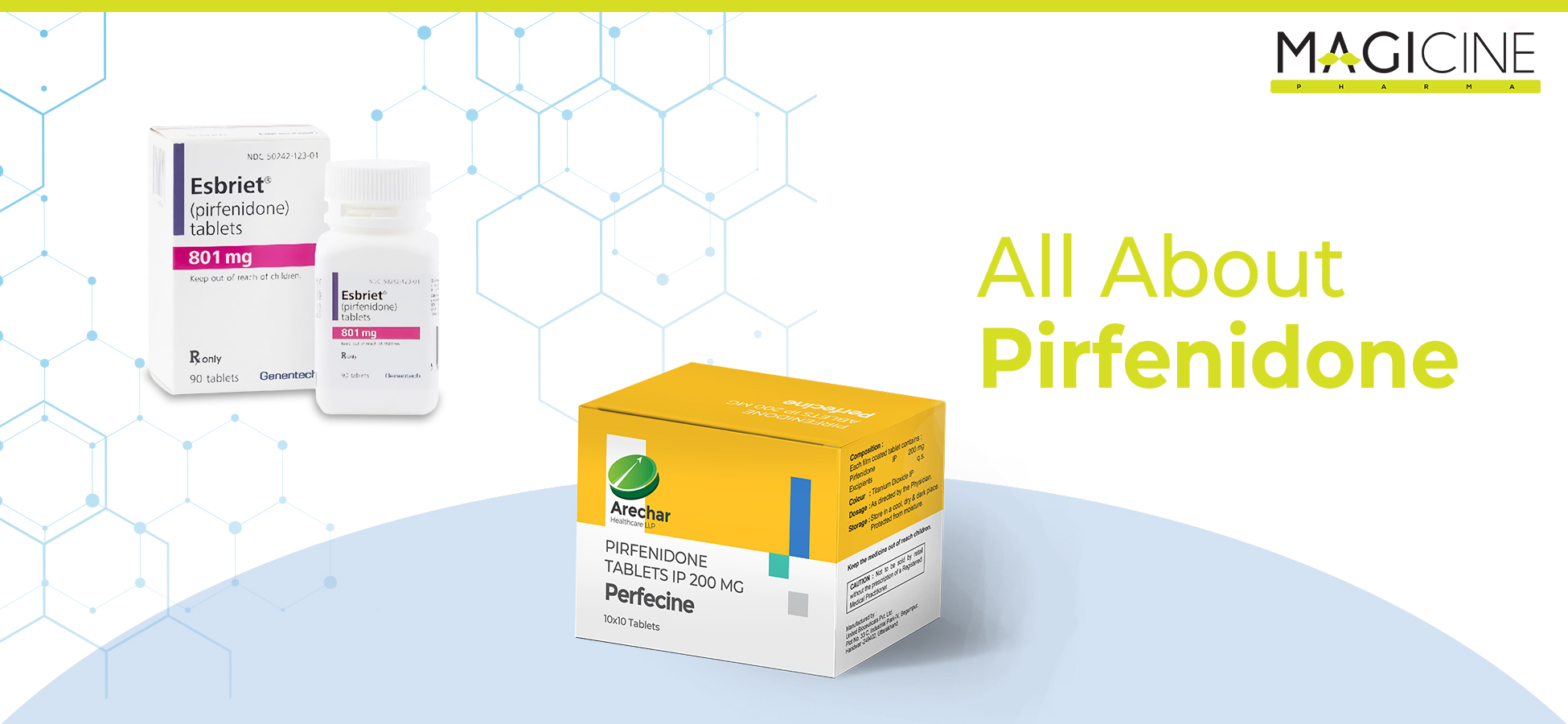
Pirfenidone is a pyridone (drug class) approved for the treatment of idiopathic pulmonary fibrosis. It is marketed as Esbriet (267 mg or 801 mg) and Perfecine (200 mg) among others. This medicine is available in the form of tablets indicated for oral use. It is known to exhibit certain properties including antifibrotic and anti-inflammatory effects.
Uses
Pirfenidone is an orally active small molecule medicine that is used in the treatment of adult patients with:
- Mild to moderate Idiopathic Pulmonary Fibrosis (IPF) - a chronic, progressive lung disease that causes scar tissue (fibrosis) to build up in the lungs.
Idiopathic Pulmonary Fibrosis is a chronic disease that causes scar tissue to grow inside your lungs. This is a serious disorder that makes it hard to even breathe. There is no cure for IPF. However, medications like Pirfenidone can slow the damage to the lungs and increase life expectancy.
Working
Being a small molecule drug, Pirfenidone interferes in the process of fibroblast proliferation. It manages the disease using the following procedure:
- STEP-1
Fibroblasts: The ubiquitous mesenchymal cells that synthesize collagen and certain other matrix macromolecules for the structural support of connective tissues are known as Fibroblasts. - STEP-2
Pirfenidone Enters: Pirfenidone works by reducing fibroblast proliferation along with the production of proteins and cytokines associated with fibrosis. - STEP-3
Reduced Severity: With its anti-inflammatory, antioxidant, and antifibrotic effects, Pirfenidone improves lung function. It does so by suppressing TGF-β1 (transforming growth factor-β1) which is a key cytokine involved in fibrogenesis.
Side Effects
Pirfenidone may lead to certain adverse effects in patients. For the same reason, the doctor may recommend over-the-counter drugs. Most of these events are moderate. Though it is advised to not ignore them if they occur for a longer period than usual.
Side effects with unknown incidence
- Cough
- Sore throat
- Hoarseness
- Tiredness
- White spots in the mouth
- Swelling on the sex organs
- Severe sunburn
- Fever with chills
Common side effects
- Nausea
- Diarrhea
- Vomiting
- Stomach discomfort
- Mouth ulcers
- Unusual bleeding
- Side pain
- Painful urination
- Weight loss
- Ear congestion
- Difficulty in sleeping
- Loss of appetite
Rare side effects
- Heartburn
- Indigestion
- Runny nose
- Sensitivity to light
- Pain around the cheekbones
- Excessive sneezing
- Body pain
- Itching
Warnings & Precautions
- Pregnancy
There is insufficient data to prove that Pirfenidone is safe for use in pregnant females or not. Thus, it is important to know the potential risks and benefits of the drug before starting the therapy. - Breastfeeding
Since most drugs are known to excrete into the mother’s milk, you may be asked to avoid breastfeeding. Though it is not evident whether Pirfenidone and inactive ingredients are excreted via breast milk. - Elevated Liver Enzymes
In clinical trials, patients treated with this medicine had a greater chance of elevated liver enzymes. This is why periodic liver exams are recommended during the therapy. If a greater probability is observed, dose modifications may be necessary. - Gastrointestinal Disorders
Some patients may experience vomiting, stomach pain, and diarrhea after the administration of Pirfenidone. Such gastrointestinal problems must be monitored during the treatment period. Certain severe cases may require dose modifications. - Photosensitivity Reaction
In the Phase 3 studies, 9% of total patients experienced photosensitivity reactions. That’s why patients may be asked to avoid exposure to sunlight. Plus, concomitant use of medicines known to cause hypersensitivity is also not recommended.
Interactions
Before prescribing Pirfenidone, the doctor usually asks for the patient’s medical history. This helps the medical team in analyzing potential interactions prior to the treatment. Further, dose adjustments can be looked upon.
Interaction with medicines: Drugs like mibefradil, viloxazine, amiodarone, fluvoxamine, ciprofloxacin, enoxacin, lomitapide, rucaparib, vemurafenib, osilodrostat, and givosiran are expected to interact with Pirfenidone. Though this is not the complete list. Experts believe that several other formulations may have an impact on this drug’s functioning.
Interaction with diseases: Certain diseases may influence how this drug works. In severe cases, the doctor may suggest dose modifications. Below are the conditions that may be considered the most.
- Hepatic impairment
- Smoking
- Renal impairment
Interaction with alcohol and food: Pirfenidone must be administered with food. This is because food helps reduce the chance of stomach-related side effects of this drug. Smoke or alcohol consumption must be avoided during the therapy period.
Overdose
The recommended dosage of Pirfenidone as per the clinical studies is given below. This drug must be administered with food to prevent gastrointestinal issues.
|
Treatment days |
Dose to be achieved with Pirfenidone |
Strength to be taken to achieve the desired dose |
|
Days 0–14 |
600 mg/day |
200 mg every 8 hours |
|
Days 15–28 |
1,200 mg/day |
400 mg every 8 hours |
|
Days 29–42 |
1,800 mg/day |
600 mg every 8 hours |
|
Day 43 onwards |
2,400 mg/day |
400 mg every 8 hours |
In case of an overdose on Pirfenidone, standard medical care is recommended by the experts. Patients may experience symptoms like anxiety, chest pain, fainting, and shortness of breath. It is advisable to seek the immediate attention of a medical practitioner in such a case.





